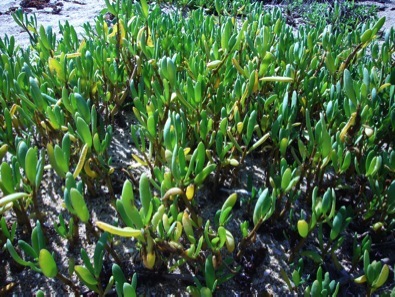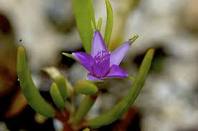Sesuvium portulacastrum: Maritime Munch
It looks like garden purslane on steriods growing in sand. And it grows all over the local beach, and other beaches in the South and as far north as the Delaware River in Pennsylvania.
Sesuvium portulacastrum (sess-SOO-vee-um por-too-luh-KASS-strum) was widely used by Native Americans. The stems were eaten raw or pickled, or cooked in two or more changes of water to reduce its saltiness. Often these days it’s found in Asians markets. One of the best-kept secrets of sea purslane is that it is a rich source of ecdysterone. Haven’t heard of ecdysterone? It’s an important chemical for molting insects and crustaceans. But, in humans it is reported to enhance athletic performance. That should make foragers out of jocks.
The lowly sea purslane forms an important and primary function in dune creation. Salt tolerant, it sets roots just above the high tide line. Sand-carrying wind hits the plant, slows slightly and drops the sand it is carrying. That helps build the dune and in time bring in other plants.
It is also found down the coasts of Mexico and South America to islands across the Pacific, Australia, Africa and Europe. As for Pennsylvania, it was found in Philadelphia county there in 1865, and presumed to still be thereabouts. On the west coast of the United States (and the salty desert southwest interior) your edible sea purslane is Sesuvium verrucosum.
It is a nice, salty, trail-side nibble. The word Sesuvium comes from the country of the Sesuvii, which was a Gallic tribe mentioned by Caesar. Why the plant was named after that is unknown. Portulacastrum means like the Portulaca, or purslane. In fact Sesuvium was originally put in the same genus as purslane but then got it own genus.
Sea purslane cooks up nice and tender, including the thick stems (remove old dead leaves first.) I’ve never found it too be salty. That said, raw, to me, it has a slightly bitter after taste, but not as strong as a raw yucca blossom. Actually it is a back-of-the-throat feeling that is between slightly puckery and slightly bitter… Easily ignored, and goes away. Cooked it looses that distraction. The older stems can be fibrous though tasty. I chew the pulp off the fiber and spit out the fiber.
Green Deane’s “Itemized” Plant Profile
IDENTIFICATION: Herbaceous perennial, thick, fleshy leaves narrow to slender obovate on succulent, reddish-green stems, branching regularly forming dense low-growing stands. Five-petaled flowers, small, showy pink, year round, Each flower opens for just a few hours each day. Leave up to more than an inch long. S. maritima very similar but leaves are no more than an inch long and are oblong to spatulate oblong.
TIME OF YEAR: Available year round
ENVIRONMENT: Along coastlines, grows on the ocean side of dunes to the high tide mark.
METHOD OF PREPARATION: Raw, pickled, cooked in two changes of water or more to reduce saltiness



